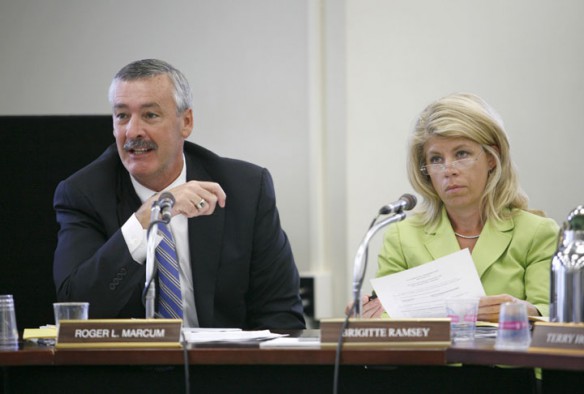
Kentucky Board of Education members Roger Marcum and Brigitte Ramsey discuss the Commonwealth Diploma during the Kentucky Board of Education meeting in Frankfort. Marcum was named the board’s vice-chair during the meeting. David Karem remained chair. Photo by Amy Wallot, Aug. 3, 2011
By Matthew Tungate
matthew.tungate@education.ky.gov
The structure of Kentucky’s accountability system is complete and has a name – Unbridled Learning: College and Career Ready for All – just in time for the beginning of a new school year.
The Kentucky Board of Education (KBE) approved regulations during its Aug. 3-4 meeting that establish which Program Reviews schools are responsible for and when those Program Reviews will be included in accountability. The board also settled on what percentage each area in the three-pronged accountability system will count, as well as the rewards, supports and consequences for schools’ and districts’ results.
The new accountability model incorporates all aspects of school and district work. It includes student data from testing, gap, growth, college/career readiness and graduation rate (Next-Generation Learners); principal and teacher effectiveness (Next-Generation Professionals); and Program Reviews (Next-Generation Instructional Programs and Support).
One of the last sticking points was when Program Reviews will be included in accountability. Schools have piloted Program Reviews in three areas: arts and humanities, practical living/career studies, and writing. Rather than testing students to see what they have learned, a school gathers evidence about how it integrates the subjects across its curricula and whether the school provides students with high-quality learning opportunities. The school then uses that information to improve its programs.
Those Program Reviews will be field tested and results made public this school year. Full accountability for the three Program Reviews will begin in the 2012-13 school year, under the regulation passed by the board. Schools will receive up to 100 points for each Program Review, and each will count equally toward a school’s Next-Generation Instructional Programs and Support score.
Also in 2012-13, Program Reviews in world language and K-3 program will be field tested and results made public. Those Program Reviews will be added to arts and humanities, practical living/career studies, and writing for accountability purposes in the 2013-14 school year.
Each Program Review will be weighted equally for accountability purposes.
Here are the weights for each performance measure:
| Grade Range | Arts/Humanities | Practical Living | Writing | K-3 | World Language | Total |
|---|---|---|---|---|---|---|
| Elementary | 20% | 20% | 20% | 20% | 20% | 100% |
| Middle | 25% | 25% | 25% | N/A | 25% | 100% |
| High | 25% | 25% | 25% | N/A | 25% | 100% |
Board members grappled with whether to require the world language Program Review at elementary schools.
Superintendents felt confident implementing world languages at high schools and middle schools, but they “strongly oppose implementation of world language at the elementary level,” Commissioner Terry Holliday said, noting his Superintendents Advisory Committee’s objection.
Superintendents are concerned that there may not be enough teacher or monetary resources and that doing five Program Reviews may be a burden, he said.
But board members strongly supported the idea of encouraging teaching world language at the earliest ages.
Board member Dorie Combs said research shows that learning another language positively affects other learning.
“We may just have to say, ‘You will teach this,’” she said. “Just because it’s hard doesn’t mean it’s not the right thing to do.”
Board member Roger Marcum, a former superintendent of the year, supported teaching world language at the elementary level even more than in secondary schools.
“Two years of high school or even middle school are not going to get you there,” he said.
Mary Gwen Wheeler had concerns.
“I think it’s kind of ambitious, and I think we have to be careful,” she said.
Board member C.B. Akins agreed, but with a different outlook.
“It is ambitious, and I think we should be proud of that,” he said.
Combs said Program Reviews, even though not fully implemented in schools, are already starting to have an effect. She is hearing from teachers that schools are paying more attention to their arts programs.
“So I think we’re having the impact that we really intended to have,” she said.
Schools’ and districts’ scores on the Program Reviews will place them in one of three categories – distinguished, proficient and needs improvement – based on yet-to-be-determined levels.
Board establishes career-ready definition
Board members had to finish one detail of the Next-Generation Learners component, which was to establish a definition for career-readiness, which combines with college-readiness to give high schools 20 percent of their score in that part of the accountability system. Board members had already agreed that a student who meets an established score on ACT, COMPASS or Kentucky Online Testing (KYOTE) is considered college-ready.
This month the board agreed that a student must meet one requirement each in the areas of Career Academic and Career Technical to be considered career ready. Career Academic includes ACT WorkKeys and Armed Services Vocational Aptitude Battery (ASVAB) assessments; Career Technical includes Kentucky Occupational Skill Standards Assessment (KOSSA) and industry certificates.
Under college and career readiness, schools and districts receive a point for each percentage of students who are considered college- and/or career-ready. The board agreed to give half a point extra to students who are both college/career-ready under the Readiness for College/Career indicator, which can total no more than 100.
Board sets weights for each accountability area
During its June meeting, board members decided that schools’ and districts’ overall scores will be based 50 percent on student data, 30 percent on Program Reviews and 20 percent on principal and teacher effectiveness, once all components are included.
However, at its most recent meeting, Associate Commissioner Ken Draut told the board that advisory groups were concerned that Program Reviews carried more weight in the accountability system than test results from science and social studies.
Holliday said he heard from state legislators who also were concerned that student data was being counted too little, and most input he received suggested it should count 60-65 percent.
Draut said a 65-20-15 weighting would give science and social studies slightly more weight than Program Reviews.
Having Program Reviews count more than social studies and science had board member Judith Gibbons concerned.
“We need to put the emphasis on the core content … and I think we send the wrong message when we say the Program Reviews have a higher value than science and social studies,” she said.
Ultimately the board decided to count student data 70 percent, Program Reviews 20 percent and teacher and principal effectiveness 10 percent.
The board also approved what would happen for schools based on the results of the assessment and accountability system.
Associate Commissioner Larry Stinson told board members that schools and districts will be classified in one of four ways: distinguished, proficient, needs improvement and persistently low-achieving.
Within each of those classifications are categories, Stinson said. For instance, the top-scoring five schools or 5 percent of elementary, middle and high school and districts, respectively, will be recognized as having high distinction, he said.
Districts classified as proficient or needs improvement may be categorized as “on the rise” if they meet certain criteria, such as being one of the top 10 percent most improved proficient schools, or moving from needs improvement-low to needs improvement-middle or from -middle to -high, Stinson said.
The revised regulation also is less specific about what recognition schools will receive. A previous version called for schools and districts that do well to be recognized with flags, Web logos and a visit from the commissioner of education. The adopted version says “Schools and districts shall receive recognition as determined by the Commissioner…,” although it does say schools will be allowed to use a Web logo and promotional materials based on their category of recognition.
The regulation also outlined how schools and districts will have to work to improve their results. These include completing improvement plans that use results of Program Reviews and the results of the Teaching, Empowering, Leading and Learning (TELL) working conditions survey, which was taken for the first time this spring.
“We’re trying to encourage folks to always be improving,” Stinson said.
In other business, the board:
- approved a waiver of the minimum requirements for high school graduation for districts involved in the State Consortium on Board Examination Systems and the Partnership for Next Generation Learning. This approval enables these districts to pursue instructional programs that provide greater opportunities to engage students and ensure higher numbers of college- and career-ready students.
- elected David Karem to serve as chair and Roger Marcum to serve as vice-chair for 2011-12
- heard from board member C.B. Akins, who resigned from the board after being appointed to the University of Kentucky Board of Trustees. His KBE term was to expire April 14, 2014.
- approved appointments to the Kentucky Writing Program Advisory Committee: Amanda Burns, Beechwood Elementary (Beechwood Independent); Nan Ternes, North Middle (Henderson County); Claire Batt, Athens-Chilesburg Elementary (Fayette County); Natalie Croney, Bowling Green High (Bowling Green Independent); Synthia Shelby, Jefferson County resource teacher
- approved 2011-12 preschool funding rates
- approved a facility plan for the Paducah Independent school district
- approved 2010-11 local district working budgets
- approved the fiscal year 2012 Kentucky Education Technology System unmet need and expenditure plan
- approved convening a stakeholder group to study whether middle schools should be required to comply with Kentucky High School Athletics Association health and safety requirements
- agreed to set Sept. 14 as the date for a hearing related to the removal of Bath County Board of Education member William Boyd
The Kentucky Board of Education’s next regular meeting is scheduled for Oct. 5 in Frankfort.



About time!
I think the best age to learn a language is the early age. You cant do very much in middle or high if you do not have a good base. Why They do not use the money to complete all Elementaries and leave High School for the students to make a choice? When you compare a 1st grade student with a High school student or 5th grade students you will see howw the 1st grade student has better results. WHY????? Just a question. .What happens with a very strong buiding if you do not make a good base? Everybody know the answer. Mr Toledo Spanish Teacher.